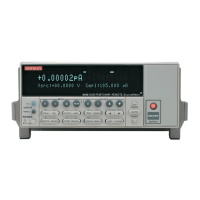SCPI Command Reference 17-29
tions, the calculation will yield one result every 10 SDM cycles. The fourth
voltage reading (vector 3) and the 10th voltage reading (vector 9) are used
for the calculation.
Now assume that the SourceMeter is configured to perform 20 source-
measure operations. Since the vector size is still 10, two 10-reading arrays
will be created. The calculation will now yield two results, one for each
array.
The first result, as before, is based on the fourth and 10th readings of the
first array. The second result is based on the 14th and 20th readings. These
are the fourth (vector 3) and 10th (vector 9) readings of the second array.
Note that you need complete vector arrays to acquire valid calculation
results. If, in the preceding example, the SourceMeter is changed to perform
25 source-measure operations, then the third array will be incomplete (first
array is 10 readings, second array is 10 readings, third array is only 5 read-
ings). After the SourceMeter goes back into idle, the “Insufficient vector
data” error message will be displayed, and the third result will be NAN
(+9.91e37).
To avoid incomplete vector arrays, make sure the programmed number of
source-measure operations (arm count × trigger count) is a multiple of the
vector array size. In the preceding example, vector array size is 10. Thus, in
order to avoid “Insufficient vector data” errors, the programmed number of
source-measure operations has to be a multiple of 10 (10, 20, 30, 40, and so
on).
The following vector math expression to calculate offset compensated ohms
demonstrates proper syntax:
:calc:math ( (volt[1] - volt[0]) / (curr[1] - curr[0]) )
Notes:
1. Use nested parentheses to force math operations that are imbedded in the
calculation. See the vector math example.
2. A calculation expression can be up to 256 characters in length, including
parentheses and white spaces.
3. When using the filter, the measured readings used in the calculation are
filtered - NOT the result of the calculation.
4. For vector math, it is recommended that only the REPEAT filter be used.
For the repeat filter, the calculations use only the filtered readings of the
vector points. If you instead use the MOVING filter, each vector point
will reflect the filtered average of all the previous readings in the vector
array.
5. The data format (ASCII or binary) for calculation results is selected
using the :FORMat:DATA? command. See FORMat Subsystem. The
*RST and :SYSTem:PRESet default is ASCII.
6. When brackets ([]) are left out of an expression, it is assumed that it is
referencing the first vector point in the array (i.e., VOLT is the same as
VOLT[0]).

